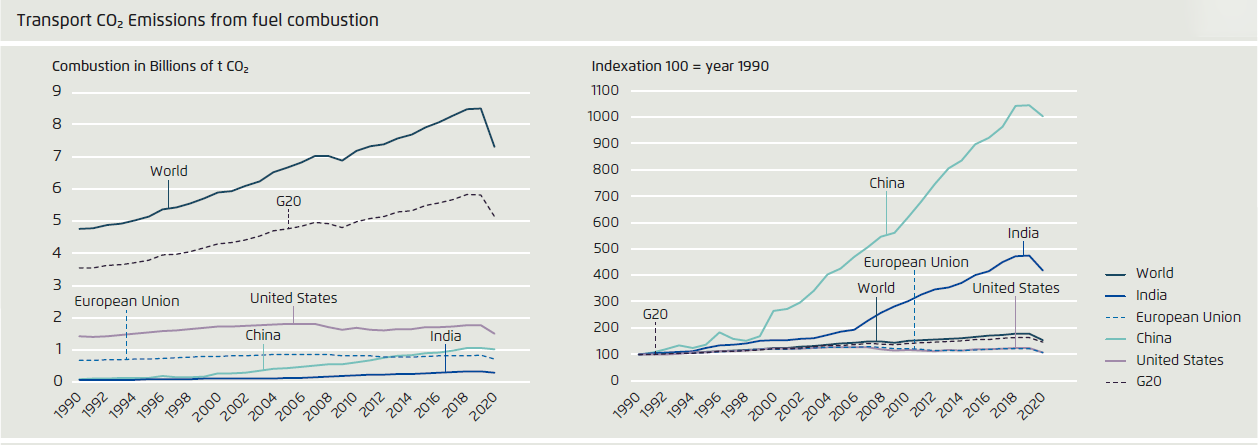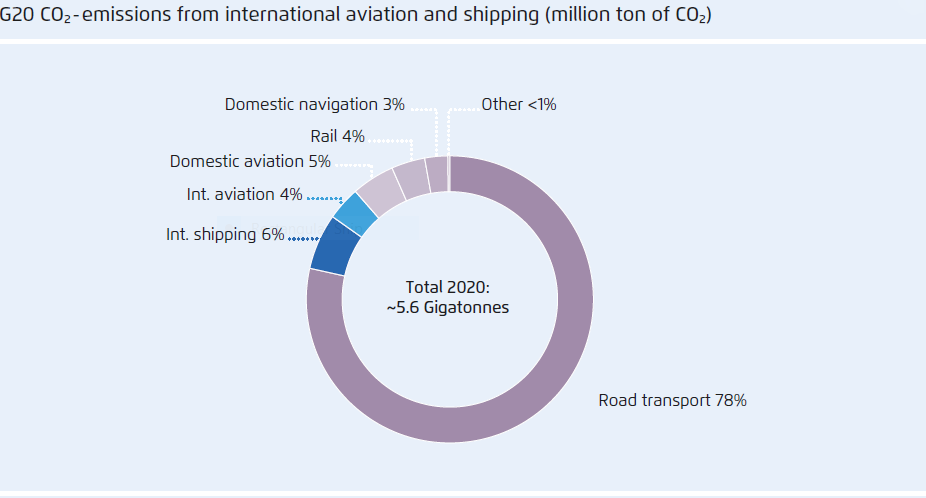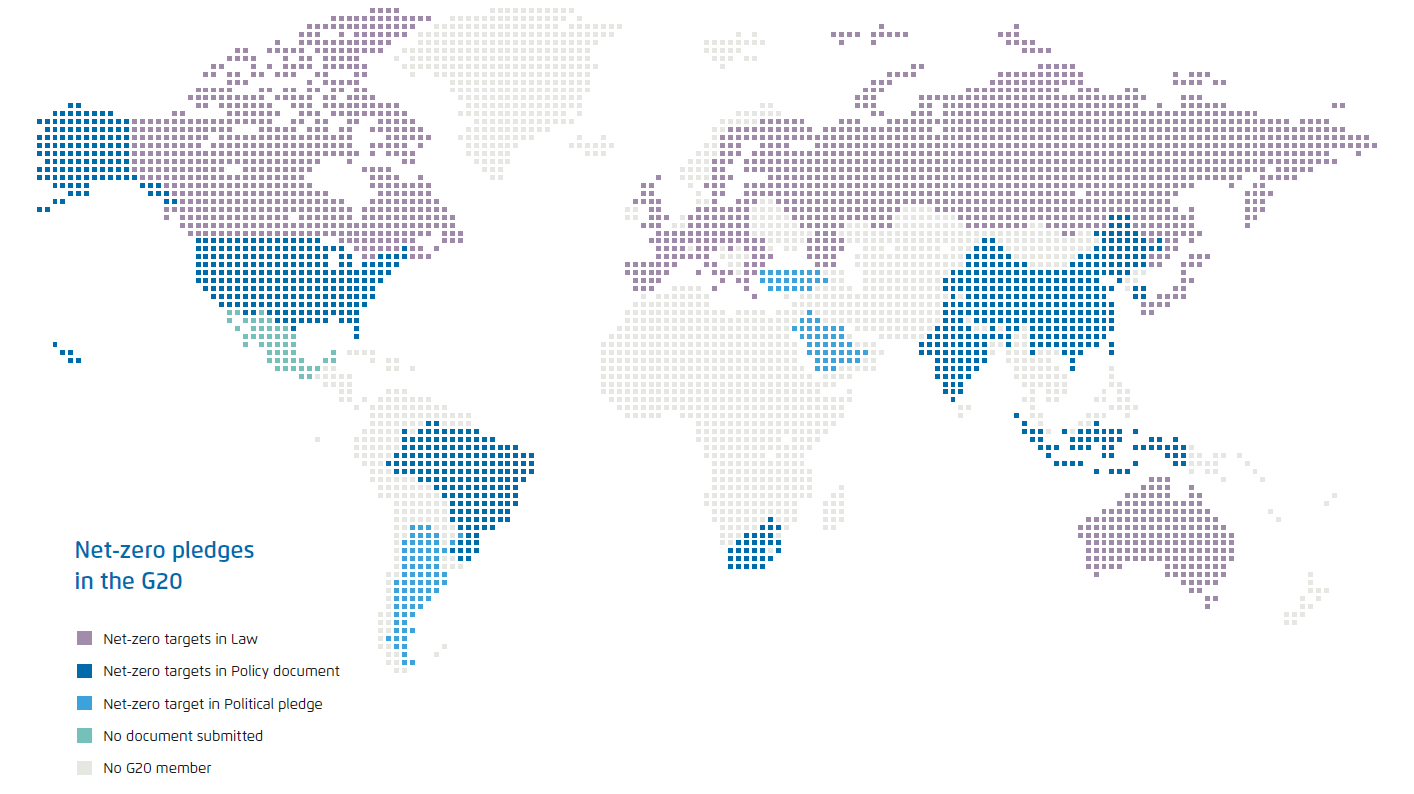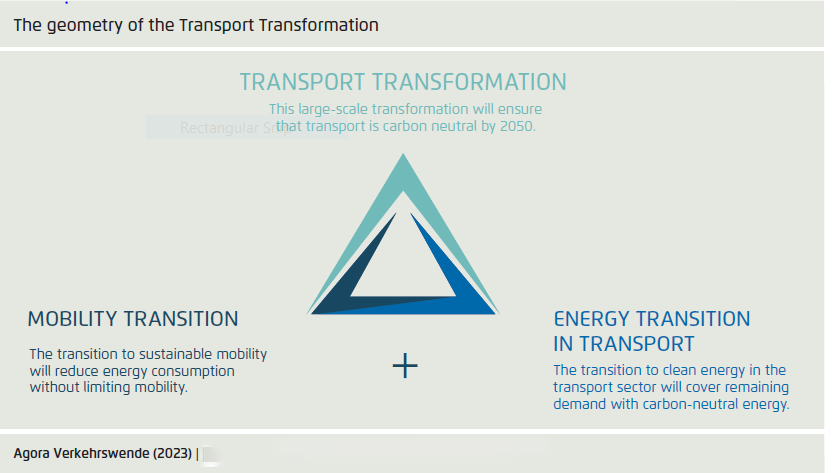Biodiversity & Environment
Towards Decarbonising Transport 2023
- 18 Jan 2024
- 24 min read
For Prelims: NITI Aayog, EU, G20, Decarbonizing transport, carbon dioxide (CO2) , Greenhouse Gas (GHG) emissions, Nationally, Determined Contributions (NDCs), Net-zero pledges, IPCC’s Sixth Assessment Report , G20, Nationally Determined Contributions (NDCs) , COP26,Greenhouse Gas (GHG) emissions,Waterways ,Electric Vehicle, Smart Cities Mission, Faster Adoption of Manufacturing of Electric Vehicles (FAME), Forum for Decarbonizing Transport, Green hydrogen, Central Electricity Authority (CEA).
For Mains: NITI Aayog Report on Towards Decarbonising Transport 2023, Need for Decarbonising Transport,National and International targets in Transport Decarbonization,National Transport-Related Targets outside NDCs, Role of G20 Countries in Enabling Transport Decarbonisation, Major Initiatives taken by India for Energy Transition,Major Recommendations for Transport Transformation.
Recently, NITI Aayog has released a report titled-Towards Decarbonising Transport 2023.
- The report serves as a comprehensive resource for assessing the current status and developments in the transport sector, with a focus on G20 nations and their climate commitments.
What is Decarbonising Transport?
Decarbonizing transport refers to the process of reducing or eliminating the carbon emissions associated with the transportation sector. The goal is to make transportation more environmentally friendly and sustainable by reducing its carbon footprint.
This involves several key strategies:
- Transition to Clean Energy: Decarbonizing transport often involves shifting from fossil fuels, such as gasoline and diesel, to cleaner energy sources like solar electricity, hydrogen, or biofuels.
- Improving Fuel Efficiency: Another approach is to make traditional internal combustion engine vehicles more fuel-efficient, reducing the amount of carbon dioxide (CO2) emissions per mile traveled.
- Public Transportation and Active Transportation: Promoting the use of public transportation, walking, and cycling can reduce the number of individual vehicles on the road, leading to lower emissions.
- Multi-Modal Transportation: Encouraging a combination of transportation modes, such as combining cycling with public transit, can reduce the overall carbon footprint of travel.
- Infrastructure Development: Building infrastructure for electric vehicle charging stations, hydrogen refueling, and alternative fueling options is critical to support the transition to cleaner energy sources.
- Policy and Regulation: Setting emissions standards, providing incentives for clean energy vehicles, and implementing congestion pricing to encourage more sustainable transportation choices.
Need
- Despite global action to keep global warming well below 2°C target, transport emissions continue to grow, which is why the efforts of G20 countries to decarbonise the sector are so important.
- Globally, the transport sector contributes about 25% of CO₂ emissions from fuel combustion and 15% of Greenhouse Gas (GHG) emissions.
- According to the latest The International Transport Forum report, by 2050 CO₂ emissions from transport will increase by 16%, even if today’s political commitments are fully implemented
- A strong increase in transport demand is expected to offset policy-led emissions reductions.
What are the Current National and International targets in Transport Decarbonization?
Global Commitments:
- Zero-emission cars : Signatories from both industrialized and emerging economies committed to achieving 100% zero-emission cars and vans by 2035-2040.
- Net-Zero Pledges to transportation : COP26 resulted in an unprecedented number of net-zero pledges and commitments related to transportation, including the Declaration on Accelerating the Transition to 100% Zero-Emission Cars and Vans
- Transport Targets in NDCs: 41% of second-generation NDCs include transport-related targets, covering both greenhouse gas (GHG) mitigation goals and non-GHG objectives.
- Nationally Determined Contributions (NDCs) under the Paris Agreement are essential for climate mitigation. The second round of NDC submissions concluded in 2021, with COP26 calling for updates and a third round beginning in 2025
- Notable G20 Actions:
- Japan set a specific GHG emissions target for the transport sector (46% reduction below 2013 levels by 2030),
- EU established emissions reduction targets for road transport, applying to all member states.
- Canada set a requirement for 100% zero-emission vehicles in its commitment to address road vehicle emissions.
- China aims for 40% of all new vehicles to be powered by clean energy by 2030, and it plans to reduce the carbon emission intensity of railways by 10% compared to 2020 levels.
- Thirteen G20 countries mention specific transport-related measures in their NDCs.
- Diverse Transport Mitigation Actions:
- Many countries also intend to shift from road to rail in both passenger and freight transport.
- The majority of new NDC climate strategies globally, not just in the G20, have a strong focus on the electrification of road transport
- Focus on Energy Efficiency: Several G20 members, such as China and Argentina, plan to promote vehicle energy efficiency through labeling, while China, the USA, and Canada aim to improve energy efficiency standards.
- Electrification of Road Transport: The majority of new NDC climate strategies globally, not just in the G20, have a strong focus on the electrification of road transport. Approximately 52% of second-generation NDCs include e-mobility-related actions.
National Transport-Related Targets outside NDCs
- Ambitious National Policies:
- Four countries outside the EU, namely Argentina, Canada, the UK, and South Africa, have set quantitative greenhouse gas (GHG) emission reduction targets for the transport sector in their national strategies or legislation.
- Australia aims to reduce 50% of carbon emissions in the passenger road transport sector by 2030 compared to 2000 levels.
- Japan and South Korea aim to increase fuel efficiency for passenger vehicles to 35 km/l by 2035 and to 7.5 km/l for heavy-duty vehicles by 2040.
- Modal Shift Aspirations:
- India envisions a substantial increase in rail freight, targeting 45% in 2030.
- The EU and India have set modal shift targets for waterways, with the EU targeting 25% more by 2030 and India aiming to double the current 6% share by 2025.
- Infrastructure Expansion Targets:
- Australia aims to construct 1,749 kilometers of high-speed rail.
- India envisions a high-speed rail network expansion of 7,987 kilometers by 2051.
- Electric Vehicle (EV) Deployment Goals:
- All of the G20 countries except Argentina and Saudi Arabia had set deployment targets for electric vehicles.
- India targets a 30% EV share in passenger light-duty vehicle (LDV) sales by 2030.
Global Net-Zero Pledges
- Many countries made net-zero pledges in 2020 and 2021, with these political commitments often reflected in updated NDCs or Long-Term Strategies (LTS) in 2022.
- According to Climate Watch's Net-Zero Tracker, 76 parties representing 83 countries and 73.3% of global GHG emissions have announced net-zero targets.
- In 2017, Sweden became the first country to enshrine a net-zero target in law,vowing to achieve climate neutrality by 2045.
- The UK followed in 2019 with a 2050 net-zero target.
- Greece, Hungary, Iceland and Spain have net zero laws.
- Germany set a net-zero target for 2045
- Finland established the earliest legally binding net-zero target of 2035.
- Many cities and companies are also making net-zero pledges:
- Mumbai plans to be climate neutral by 2050
- Global corporations like Siemens aim for net-zero emissions by 2030.
What is the significance of G20 Countries in Transport Decarbonisation?
- Major Political and economic contributors:
- G20 countries are home to over 4.7 billion people, accounting for 62% of the global population. By 2050, approximately half of the world's population is expected to reside in G20 nations.
- G20 countries collectively account for almost two-thirds of the world’s population, around 80% of global economic output, nearly 75% of global exports, and more than 80% of current global CO₂ emissions.
- High Urbanization:
- G20 nations are highly urbanized, with a substantial percentage of the population living in cities. Per capita emissions in G20 countries are significant and will continue to have a disproportionate impact on global emissions.
- For instance, in Argentina, 92% of the population resides in urban areas.
- The G20 collectively produces around 80% of global economic output, nearly 75% of global exports, and is responsible for over 80% of current global CO₂ emissions.
- G20 nations are highly urbanized, with a substantial percentage of the population living in cities. Per capita emissions in G20 countries are significant and will continue to have a disproportionate impact on global emissions.
- Major Carbon Emitter :
- G20 countries are responsible for nearly 70% of worldwide transport emissions, emitting around 5.8 billion metric tons of CO₂ from fuel combustion.
- Transport emissions are closely tied to economic prosperity, the movement of people and goods, and have been a persistent challenge. Globally, the transport sector contributes about 25% of CO₂ emissions from fuel combustion and 15% of Greenhouse Gas (GHG) emissions.
- CO₂ emissions since 1990, they still contribute two-thirds of these emissions.
- Despite the COVID-19 pandemic's impact on emissions, it did not significantly alter the overall share of transport emissions from previous years.
- Growth in Transport Emissions:
- Transport emissions have seen a substantial increase, with a 64% rise in G20 countries and a 79% increase worldwide since 1990
- Between 2015 and 2019, G20 countries saw a 6% increase in transport-related emissions, indicating the persistent challenge of reducing emissions in the sector.
 |
 |
What are the Challenges Faced by Individual G20 Members in achieving Transport Decarbonization?
- Infrastructure and Investment:
- Developing and upgrading transportation infrastructure to support sustainable and low-carbon modes of transport, such as electric vehicles (EVs), requires substantial investments in charging or refueling stations, public transportation systems, and sustainable urban planning.
- Technological Adoption:
- Encouraging the adoption of cleaner and more efficient transport technologies, like electric vehicles, can be hindered by factors such as high initial costs, limited availability, and consumer reluctance to switch from traditional fossil-fueled vehicles.
- Regulatory Frameworks:
- Establishing and implementing effective policies and regulations to incentivize cleaner transport options and penalize high-emission vehicles is often met with resistance from industry stakeholders and requires political will and public support.
- G20 members face contesting challenges in achieving socio-economic transformation, especially in the remaking of the transport sector.
- Energy Transition:
- Transitioning to renewable energy sources for transportation, such as clean electricity or sustainable biofuels, can be challenging due to the existing infrastructure and vested interests in fossil fuels, making it necessary to develop comprehensive energy transition plans.
- The energy sector's transition to renewables presents challenges, particularly regarding core economic sectors like vehicle manufacturing.
- International Cooperation:
- Collaborating with other nations on issues like emissions standards, cross-border transportation, and harmonizing policies can be difficult due to geopolitical tensions and differing national priorities.
- Shifts in geopolitics have led to greater economic competition between emerging economies and industrialized countries.
- Behavioral Change:
- Encouraging people to adopt more sustainable travel behavior, such as carpooling, public transit, or active transportation, can be challenging due to cultural norms and lifestyle preferences.
- China, India, and Indonesia have relatively low per capita emissions but face significant increases in absolute transport-related emissions.
However, there are also positive trends when it comes to sustainable transport in G20 countries :
- Growth in Electric Vehicles (EVs):
- The market for electric vehicles (EVs) has seen significant growth in recent years. In G20 countries, the EV fleet expanded almost eightfold from 2015 to 2020, reaching 8.4 million vehicles.
- Electric vehicle new sales in G20 countries reached 1.6 million in 2020.
- International Energy Agency (IEA) scenarios forecast significant growth in the cumulative EV stock fleet for China, India, the USA, and the EU, ranging from 123 million to 195 million EVs.
- Charging Infrastructure:
- As of 2020, G20 countries had 560,000 slow charging points and 330,000 fast charging points in publicly available charging infrastructure, with an average ratio of around 10 electric vehicles per public charging point.
- Data limitations exist as only 14 countries provide up-to-date information for electric cars, and even fewer offer current data for buses, vans, or two-to-three wheelers.
- Transition to Clean Energy:
- G20 countries show a clear trend toward decarbonization, with the average share of renewables in G20 countries being around 28% in 2019 (approximately 25% if weighted with respective total electricity generation in terawatt-hours) and increasing by nearly 5 percentage points.
To maintain operational transport systems while avoiding long-term disadvantages, countries must prioritize investment in clean, renewable, and efficient modes of transport.
What are the Major Initiatives taken by India for Energy Transition?
- G20 Presidency:
- India holds the G20 presidency in 2023 and aims to shape the global climate agenda from the perspective of emerging economies.
- India's motto for its G20 presidency is "Vasudhaiva Kutumbakam," emphasizing "One Earth One Family One Future."One of its six priority areas is creating a "clean, sustainable, just, affordable, and inclusive energy transition."
- India's Updated NDC:
- India submitted its updated Nationally Determined Contribution (NDC) to the UNFCCC in August 2022, incorporating its climate action elements from COP26.
- Key targets in India's NDC include reducing emissions intensity of GDP by 45% by 2030 (compared to 2005 levels), achieving 50% non-fossil fuel-based electricity capacity by 2030, and promoting a sustainable way of living.
- COP26 Declaration:
- The COP26 declaration targets transitioning to 100% zero-emission cars and vans by 2040.
- Transport and Emissions:.
- Despite its strong growth rates, India's per capita emissions are the lowest in the G20 at 0.25 metric tons CO₂.
- India aims to increase the share of rail in freight transport to 45% by 2030 and targets a 30% share of electric light-duty vehicle (LDV) sales by 2030.
- National programs, such as the National Urban Transport policy and the Smart Cities Mission, aim to reduce vehicle traffic and enhance transport efficiency
- Emissions-Reducing Fuels and Energy Storage:
- India has introduced initiatives like blending petrol with 20% ethanol to reduce emissions. The target year was moved up from 2030 to 2025.
- India has laid out a detailed plan for energy storage systems to increase the grid integration of renewable energy, with fuel cells playing an important role in this transition.
- Electric Mobility in India:
- India's EV market is evolving rapidly, with approximately 0.32 million vehicles sold in 2021, marking a 168% year-on-year increase.
- The Indian government has been proactive in promoting electric mobility, launching initiatives like the National Electric Mobility Mission Plan 2020 (NEMMP), Faster Adoption of Manufacturing of Electric Vehicles (FAME) Phase I and Phase II, and earmarking substantial funds to incentivize demand for EVs and develop charging infrastructure.
- NITI Aayog launched the Forum for Decarbonizing Transport in 2021 to foster stakeholder engagement, encourage policy action, and facilitate international knowledge exchange.
- Transition to Green Energy:
- Achieving net-zero emissions by 2070 in India would require a significant shift, including 5,630 GW of solar capacity, a 99% reduction in coal usage between 2040 and 2060, and a 90% decline in crude oil consumption between 2050 and 2070.
- Various mechanisms in India promote renewable energy, such as Renewable Purchase Obligations (RPO) mandating minimum renewable quantities for distributors.
- The "solar cities" program aims to convert one city per state in India to run entirely on solar power.
- Nuclear Energy:
- India's nuclear energy program has remained at a share of around 3 to 3.5% of total electricity generation since 2014.
- As of March 2022, India had 6,780 MW of installed nuclear power capacity, with plans to increase it to 22,480 MW by 2031 as part of its infrastructure development program.
- Green Hydrogen and Energy Independence:
- India aims to become an energy-independent nation by 2047 and considers green hydrogen as an alternative to fossil-based products.
- In 2020, India's hydrogen demand was 6 million tonnes per year, and it envisions green hydrogen meeting 19% of the industry's needs by 2070.
- India aspires to become a hydrogen exporter to countries like Japan, South Korea, and Europe.
- Energy Storage:
- India is working on a comprehensive policy framework to promote energy storage in the power sector, with a goal of creating large-scale storage systems nationwide.
- The government's immediate target is to set up 4,000 MWh of battery storage capacity to increase renewable energy penetration in the national grid.
- The Central Electricity Authority (CEA) projects that 27,000 MW/108,000 MWh of battery storage capacity (or four hours' worth) will be installed by 2029–30
What are the Major Recommendations for Transport Transformation?
- Transitioning to Sustainable Mobility:
- Achieving a successful "transport transformation" requires a "mobility transition" and an "energy transition in transport."
- The "energy transition in transport" aims to transform technology to meet mobility demands efficiently while generating fewer emissions.
- Promoting Energy-Efficient Transport:
- Increasing investments in energy-efficient passenger and freight transport can shift consumer demand toward lower-carbon options.
- Electric vehicles (EVs) offer better energy efficiency, producing about 20% fewer CO₂ emissions than internal combustion engines.
- Private companies like Audi and Jaguar, supported by GridCars, are installing public EV charging stations in South Africa.
- In India, two- and three-wheelers are widely used modes of transport, and the country has set a 2030 electrification target for these modes to reduce carbon emissions.
- Urgent Need for More Ambitious Action:
- To achieve the objectives of the Paris Agreement and uphold COP26 commitments, more ambitious efforts are needed in the transport sector.
- While some countries have made promising policy developments, a marginal decrease (-0.15%) in year-over-year growth in transport-sector emissions was observed in 2019.
- Overall G20 transport emissions increased by almost 6% between 2015 and 2019.
- Policy Measures to Reduce Transport Demand:
- Policies that reduce transport demand are needed, and modern communication technologies, such as video conferencing, play a crucial role.
- Access to reliable, high-speed communication infrastructure is essential for harnessing technology to lower transport demand.
- Complementing Efficiency with Weight Reduction:
- Efforts to increase the energy efficiency of light-duty vehicles should be complemented by measures that encourage the use of smaller, lighter vehicles.
- Renewable Energy for Electrification:
- Electricity used in the transport sector should come from renewable sources.
- Support measures for electrification or power-to-X technologies should be linked to renewable energy requirements.
- Decarbonization efforts in land-based transport and expansion of power-to-X fuels for aviation and shipping should be based on renewables to be effective.
- Grid Emission Factors and Energy Transition:
- Grid emission factors reflect progress in the energy transition of the power sector in G20 countries.
- While most countries show moderate improvement in grid emission factors, Brazil, Indonesia, Japan, and South Africa have higher GHG emissions per kWh compared to 1990.
- Power-to-X Fuels for Decarbonization:
- Long-haul aviation and maritime shipping still depend on energy-dense fuels.
- G20 member states should lead the market ramp-up of power-to-X by adopting ambitious policies, increasing funding, and fostering cooperation between states.
- “Power-to-x” refers to a series of techniques and pathways allowing to convert, store and utilize renewable electrical energy.
- Elimination of Fossil-Fuel Subsidies:
- Several countries, including India, have begun to reduce fossil-fuel subsidies.
- Fossil-fuel subsidies distort the market, favoring carbon-intensive transport modes.
- Eliminating these subsidies would free up resources for public transport, electrification, and zero-carbon fuels.
- Need for Integrated System Approaches:
- The transport sector requires integration with other sectors like electrification and digitalization.
- The G20 should establish a work stream dedicated to transforming transport to identify measures promoting greater integration and guide decarbonization.
Conclusion
Thus, solely emphasizing on vehicle technology, such as fuel standards and electrification, falls short of achieving effective decarbonization. To address this challenge comprehensively, a holistic approach is required that not only promotes efficient, less carbon-intensive modes of transportation but also embraces an integrated system approach.
The integrated system approach should encompass addressing grid emission factors, investing in power-to-X fuels, and eliminating fossil-fuel subsidies, all of which are crucial steps toward advancing the energy transition and achieving decarbonization within the transport sector.








